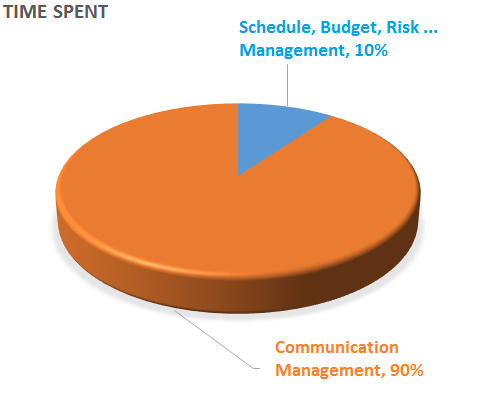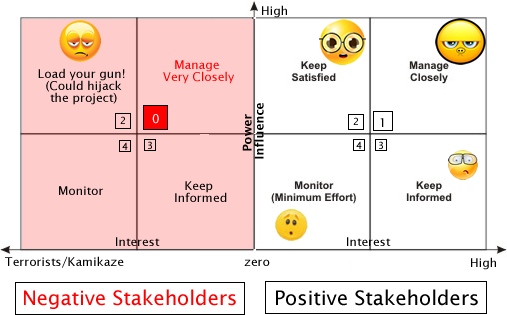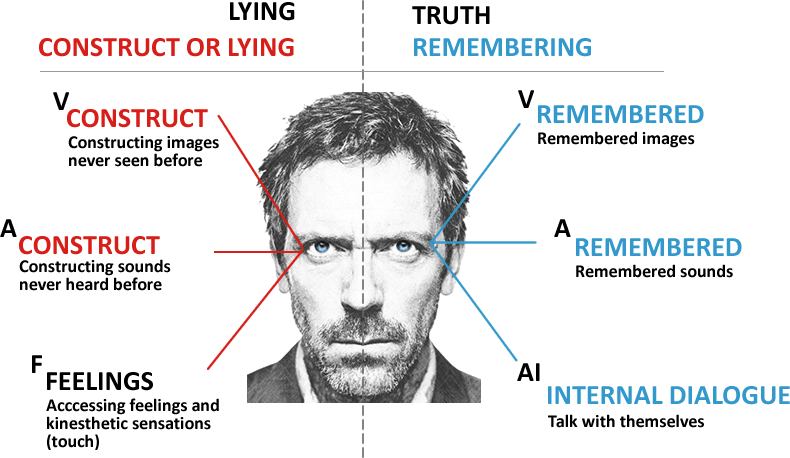How important is communication?
Posted on September 20, 2013 by ThePMJournal
From a theoretical perspective, Communication Management seems to be one of the most easiest area of knowledge in project management. In reality it is the touchstone for most managers, even for those with experience. Why is communication so important? Because 90% of the work of a manager means: communication.
Here’s how it looks for the PM’s time spent on different areas of knowledge:
Although in PMBoK, the communication is described as a sum of processes present in 4 of the 5 groups of project management processes: initiation, planning, execution, monitoring&control, we should not forget in reality it occurs in all groups of processes, including closing processes (in the 5th group of processes) when clients signoff for the product/service delivered and celebration party for finishing the project occurs.
The main cause of projects failure, regardless of the level of management to which we refer (project, program or portfolio), is communication: someone did not understand the objectives, a team member did not understand what to do (project’s scope), the needs of a customer were not taken in consideration, etc.. are examples of poor communication that can lead to project failure. Communication is essentially made only by three components: verbal, non-verbal si paralingual.
Unfortunately, in most books of Project Management, communication is treated superficial and its importance is underestimated in the context of the project cycle. First to emphasize the importance of communication in project management were Agile creators. Also, companies rapidly understood the value of communication (communication is directly correlated with customer service, quality, productivity) and that’s why “Agile” has become so popular vs traditional development methodologies. In the same idea, PMI PMBoK (version 8 a) recently created a dedicated chapter for communication management. Also any modern project management theory emerged into a new concept called “Agile Project Management”.
Everyone who works as PM, certified or not, know very well the theory behind project management: are true specialists in communication planning, are endowed with a tremendous arsenal of theories, can make brilliant presentations, but when it comes to effective communication, most fail to have a good relationship with noone around them. As a fact, communication theory is so bushy and difficult to apply in practice, so, in the future, it could be invented a new job in the management of projects, namely: manager of project communication.
Communication is the weak point for most PMs as communicating “better” is not always depends on knowledge and learning. For example, Non-verbal communication (gestures involuntary tics, grimacing, etc.) is almost impossible to control. Non-verbal and Paralingual Communication betray our anxiety, fear, ecstasy and other inner emotions that make us sometimes nice, sometimes obnoxious, and depending on each situation, is getting us closer or farther from a good communication.
To avoid wasting time, explaining the theory behind the communication, I will go directly to one of the conclusions we reached by experimenting communication management.
“Good” Communication begins with being happy
When two people talk, they create an emotional link. If one is stressed or feels uncomfortable, most likely the other will feel. In communication, no matter how someone is trying to hide their feelings behind the words, the non-verbal and paralingual communication will betray him. So is highly important to be in a good emotional shape before you start a conversation.
One day, I went furious at the office: my projects were always behind of schedule, my team lacked the involvement in the project, above all I felt frustrated. During that daily meeting, I got angry and I started criticize harshly everyone in the team… I was terrible. After that, things started to get even worse than before: the people not only delivered a poor quality work, but they avoid any face to face meeting. The tension lasted almost two days. Key stakeholders were not impressed by the drastic measures I have taken, on the contrary, they have complained me that “everything is going wrong in this company” and I am the only responsible for the company’s decline.
The only thing come in my head was: I ruined everything! People hate me, the top management is blaming me for the failure of the company. I felt depressed, I blamed others, I blamed myself, I wondered what I did wrong? I could not sleep a wink because of my dark thoughts. After I got really exhausted, physically and mentally, I suddenly stopped. I decided to stop because I couldn’t hold up anymore. I said “no matter the consequences, I will not torture myself in this way. I will stay peacefully imagining all things are going very well“.
I expected my attitude will infuriate the leadership, but things happened in a different perspective:
-Gentlemen , today I will give you good news! I know we’re in deep shit, but by the end of the day we will solve all the problems and we will all leave home happy!
CEO and all “bad guys” (The Experts), they all looked surprised and said me:
– Okay! Let us know when things are done.
Then, in the meeting with team leads, I was very calm and I told them:
– Today is a very big day for all of us. We reviewed the situation in which we find ourselves and we know we have some big problems… But you know what? I do not care! I know we will solve these problems and I assure you that everything will be fine. I’m tired about stakeholders complains, I am tired about the fact we are considered to be incompetents. Today, no matter other say, I will choose to be very happy and nothing can stop me to do this! I suggest you do the same thing, because that’s got to be.
Surprisingly, in that day we delivered everything on time and everyone went home with a smile on his face.
My experience: that of being unhappy and the choice of being happy confirmed me the inner emotions can negatively or positively influence the communication results. That day I chosed to be happy all the people I interacted with were also happy. Being happy provides psychological comfort to everyone and communication becomes much easier.
I recently read an article in psychology which says:
Happiness is a choice!
This thought is one of the most profound truths I’ve ever heard. From the moment I chosed to be happy, everything worked much better in my communication with people! So good communication starts with being happy.
Know thyself
Sometimes, analyzing my face in the mirror makes me wonder:
That is my mouth that speaks? So I move my lips? So I turn my eyes? Is so I see myself in the eyes of others?
Know your eyes! It is obvious that the way I see myself behind my eyes is different from what others see in me when I watch. Recently I have gained some weight, but in my mind I am still slim as at 25. Every time you speak, the image I want to project for others is the image of me at 25, flat stomach and presentable. To be able to project my image I must communicate through looks, hands, gestures, glances, not only verbally. It is very important to understand your body language and what gestures can help you project the image you want.
Listen to your voice! In an experiment, I used cell phone to record myself, I noted with amazement how little I know my voice. I exclaimed: This can not be my voice! It’s too thick, too unconvincing and has a strange accent! The biggest challenge related to my voice was to control the tone, something that is not easy to manage, because voice tone is unconsciously (paralingual communication).
One day, I decided to record all my negations I use in common language, and the result was shocking: “I can’t,” “I do not know”, “Don’t do that!”, “You do not understand” were present in almost any of my ideas. Seeing the large number of negations used, I started to remove negations from my vocabulary. Just eliminating the word “No” and all expressions with negative connotation, I noticed a significant improvement in the way I was perceived: -Oh, you’ve changed! Today you are more cheerful! I like your thinking! It’s an interesting idea!
But what communication comes down to?
To understand what communication is in essence I sought the answer in people:
-Can you give me advice how to improve my communication?
Most gave me the following advice:
-To improve your communication, offers something! Everyone likes to receive!
So communication means “to offer”, “to give”. When a neighbor asks you to help him, your help will not be forgotten! If your mate fails to do its job, help him because he’s likely to return you the same service! When you go abroad, do not forget to buy your boss a little souvenir, even if it costs $5, the gesture is priceless! Find out when is your colleagues birthdate and prepare them in advance a customized gift (original gift does much more than an expensive gift).
I would I would like also to add few examples in which “to offer” is considered an efficient way of communication, in an extended version till grotesque. At one of the companies I worked, top managers have allocated budgets for protocol meetings. In this budgets beside a lunch meal, people might exchange properties, expensive gifts, trips to exotic islands with escorts included, etc… throughout history mankind, many important events have ended in a relaxing atmosphere around a heavy meal and alcohol vapors… obviously tables aim to create a friendly environment, in which people feel polite but in the same time relaxed (maybe too relaxed after two-three glasses of wine when language become inappropriate).
Offering a gift or a service is an effective way to begin the communication, but not enough to maintain it. Communication is supposed to be delivered consistently with a kind word, a handshake, a thank you, a compliment and so on and the “healthy” way to do this is to give (to offer) unconditionally and cheery.
Communication involves increasing circle of influence
In the communication management there are two key processes that can positively or negatively influence project success: identifying all stakeholderilor and managing stakeholder expectations. One of the biggest mistakes we have made over the years in project management, it was either that we have not identified all the stakeholders, or have minimized the role that each stakeholder can have within a project.
In the identification of stakeholders, can use a diagram as below:
Theory classify the stakeholders using two key-factors: decision power/influence and impact on stakeholder. Experience showed me these factors are not enough to identify all the stakeholders, especially so called stakeholders from “shadow”. What means “shadow” in this context? These stakeholders have no direct influence on the project (but may have an indirect influence) and they are not directly interested and/or influenced by the outcome of the project. This category of stakeholders includes generally low-middle class employees or close friends of the key stakeholders, which are pretty hard to see/identify them among other key players in a middle or big company. In almost all companies I worked, there was at least one stakeholder “shadowed”: a relative or close friend to someone from top management: a “secretary – mistress”, the godchildren, the godparents, the bosses wives, etc. Lack of communication with these “apparently” insignificant stakeholders, almost costed me my job and project’s success. After I got stung myself few times, I started to pay attention to people who can influence key stakeholders. So I expanded the list of stakeholders with: known acquaintances and friends of key stakeholders. By managing closely the relationships with stakeholders from “shadow”, it helped me to communicate much easier with key stakeholders.
Also related to key stakeholders communication, it is worth mentioning the role of a project’s Sponsor. It is essential that the sponsor will be informed verbally and in writing about the status of the project (here need to be established a very detailed method of communication: the report format, what’s his expectation, when he really wants, etc). Warning: unmet needs or expectations of the Sponsor may result in termination of the project or dismissal of the Project Manager!
How can we improve communication?
Improve communication helps us get what we want easily . There are books and a large number of articles on methods can improve our communication, but nobody has yet found a recipe ” magic ” that works for everyone.
Since communication between people is “beyond words” ( only 10% of communication is verbal) means that 90% of effective communication is non-verbal and paralingual communication. To improve non-verbal communication and paralinguale, we need to know how to interpret gestures, tics, mimic face, voice, etc. . Interpretation of non-verbal language and paralingual can be found in psychology and neuropsychology studies. Some studies teach us how we can interpret body language: i.e. studies about eye movement tell us how to “read” when someone tell a truth or a lie. Below is the significance eye movement:
Therefore, a person who looks to your left, it’s possible to lie… Of course, that does not mean non-verbal analysis is the ultimate lie detector, because knowing how to interpret eye movements, we could falsify the test results next time: when we lie, we will look left, to simulate the truth.
For each type of communication there are different techniques to improve communication, however, even if you manage to improve your personal techniques, it is not enough to have good communication in any situation with everyone. The main reason is people do not speak the same kind of “language”.
Splitting communication in three: verbal, non-verbal and paralingual communication does not help us understand why people do not understand each other, that’s why some psychologists have thought to categorize communication in these types:
The basic idea remains the same: only 10% of language is verbal, and the rest of 90% is visual, tactile, auditory and internal dialogue, but proportions of visual, tactile, internal languages may be different from person to person. We know that people communicate predominantly only with one type of language, which means if we could identify main “language” of your companion, we will be able to communicate efficiently.
An example: Suppose that we are in a position to communicate with an introvert. We know he is introvert, so we can logically assume his main language is predominantly auditory and meditative. Introvert prefers to listen, so he will always expect you to take initiative in the discussion, which can be an advantage.
General tips to improve our communication
Probably few of us have enough time or mood to improve the way communicate. Most will want to improve communication only by using some magic “recipe” or “profond” advices from books. Unfortunately there is no magic solution to improve communication, but there are some general tips that you can be used in all the situations:
- always keep the eye’s contact
- synchronize with the interlocutor: voice tone, movements, posture, eye blinking etc. Note: The synchronization does not necessarily mean being a mirror, because it will be more than obvious you imitate. The goal is to make your companion feel comfortable with your presence. Those are look alike, they like each other!
- experiment the power of tactile senses. I read an article that highlight how important it is “physical contact” in communication. The subject was about protocol meetings between two heads of state: United States and Russia. In essence, the communication protocol is very complex: they shake hands, they touch the shoulders, their suits, etc. Tactile communication is a very powerful method of communication. Knowing this, I discovered that through a handshake or a discreet touch on one’s shoulder you can make a person very responsive (or even you can dissipate the negative emotions)
The scientists went much further to improve communication techniques. There are very interesting studies that come to explain how can we control our negative emotions, how can we influence others, how can we program our subconscious and other wonders of modern science that seem detached from a paranormal story.
Studies related to NLP (Neuro Lingvistic Programming), went so far, nowadays you may think the words can manipulate anyone, anytime (this can be taken to the rank of paranoia as we may think we are victims of a huge conspiracy). One example of NLP that I particularly like and I have experienced refers to the power of words. I’ll take a concrete situation in which you propose to communicate on a subconscious level with a person you want to have a relationship. We start from the following sentences:
“You are incredible. It’s amazing how many interesting things you like… me personally I prefer to think that I have one single passion: traveling.”
“It’s extraordinary what you did! I understand you perfectly.”
“Let’s go for a walk together. It’s a wonderful day!”
The statements contain several combinations of keywords: I, you, you like me, I .. you (are) perfect, together (is) wonderful. The keywords, seemingly trivial, creates at subconscious level a connection between you and the person you’re talking. Note: The bond is obtained by a using certain sequence and repetition of words, but also can be obtained by accented keywords (voice tone).
Many would consider NLP a technique of manipulation and, in a sense, it is. Fortunately, very small number of people are able to use efficiently NLP techniques and other methods of mind programming. But, whether we like it or not, people are biological computers, indeed very sophisticated and similar to computers can be re-programmed. By improving communication techniques, we can change the way we think, our mood, our emotions and ultimately help us to improve our lives.
An example of successful communication…
Returning to communication management in the management of projects, the main target of a manager is meeting stakeholder expectations. In other words, the ultimate goal of a manager is to have good relations with all the others and especially with key people inside a project. Unmet expectations of stakeholders can lead to failure of the entire project regardless of how well managed the other plans: time, budget, etc.
I recently attended one of the Agile workshop on “how to meet customer expectations“. In the workshop, we experimented with a group of fellow ways the improvements of communication with clients. Following the debate, we concluded that to meet the expectations of stakeholders we always have to begin with the following premise:
-Clients do not want from you to be precise, but want to hear from you that you are sure.
Consider the following example. A client asks:
-When will we release the product?
An answer like, “I do not know, but I suspect it’s somewhere in the six months” is an answer nobody wants to hear …
Also, an answer like “product will definitely be released in six months!” it is not too good, because you take an unnecessary risk by choosing an inflexible deadline.
But an answer like: “Based on the projects history (development speed, lessons learned) and complexity of the current project, I estimate it could take between a minimum of four months and a maximum of six months” everyone will enjoy and will say: “Man is wise, he seems to know what he is talking about. He spoke the truth“. Although the answer is not “exact”, it communicates safety, certainty and this may be an example of successful communication.
Recommandation: Lead by Experimenting














What Others Are Saying